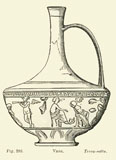Previous First Next
SALAMIS IN THE ISLAND OF CYPRUS.
BY ALEXANDER PALMA DI CESNOLÀ, F.S.A.,
page 122
 resemblance of these four little aryballi makes it reasonable to believe that they owe their origin to one and the same designer. Among the curiosities of pottery to be found in this numerous aggregate is a basket, like a carpenter's basket, containing a bottle, the neck of which emerges at the side, while the edges of the basket have been sewn over the bottle. This relic (fig. 294) has evidently been made in a mould taken from "nature", i.e., from a real basket and bottle, the meshes of the woven rushes are unmistakeably due to"the life". The inscription in relief on one side is ΔΙΟΔΩ; on the other ΔΙΟΩ in terra-cotta are undoubtedly bottles; resemblance of these four little aryballi makes it reasonable to believe that they owe their origin to one and the same designer. Among the curiosities of pottery to be found in this numerous aggregate is a basket, like a carpenter's basket, containing a bottle, the neck of which emerges at the side, while the edges of the basket have been sewn over the bottle. This relic (fig. 294) has evidently been made in a mould taken from "nature", i.e., from a real basket and bottle, the meshes of the woven rushes are unmistakeably due to"the life". The inscription in relief on one side is ΔΙΟΔΩ; on the other ΔΙΟΩ in terra-cotta are undoubtedly bottles; thereis, of tins class, the figure of a goose, thrusting forth its head; another is a squatting hen or duck about to take to thewater; a third is a dove crouching, as if on the ground. A strange bottle is that which resembles an inverted amphora, witha neck stuck in itself; this is a monstrosity which would have shocked a decent Greek. Among the oddest of these thingsis that rather large one shaped like a child's whipping-top, and furnished with three bottlenecks. Several examples illustrate the same types of design, in form and direction, which Dr. Schliemann found at Hissarlik; a great manyΔΙΟΔΩΡΟΣ ΔΙΟΩΚΛΕΟΥΣ—perhaps abbreviations of ΔIOΔΩPOΣ ΔIOΩKΛEOΥΣ—"Dio-dorus, the son of Diocles." Some of the oddly-shaped articles of them are so bizarre, that not all the courage and learning of that explorer could account for them.Of later styles, I place here a vase, perhaps a variety of the olpe, resembling a lecythus, with a bowl-shaped body (fig. 295) and ample handle, the lower part adorned with petals or leaves, and the upper part of the bowl ornamented with a narrow band or frieze of ivy leaves. Hound the bowl is painted in black colour a scene, which commences with a tripod or altar and a faun dancing before it, as in the accompanying woodcut (fig. 296). Two winged boys, playing on a pipe or trumpet; a female harpist, resembling a terra-cotta statuette of a harpist in the collection, to which I have already drawn the attention of the reader; two seated figures with the knees crossed, and the hands resting on them in a pensive and attentive attitude; and three groups of a male figure apparently lifting or sustaining the frenzied or fainting form of a bacchante or mǽnad who has become exhausted by the music and revelry in which she has probably borne a conspicuous part. thereis, of tins class, the figure of a goose, thrusting forth its head; another is a squatting hen or duck about to take to thewater; a third is a dove crouching, as if on the ground. A strange bottle is that which resembles an inverted amphora, witha neck stuck in itself; this is a monstrosity which would have shocked a decent Greek. Among the oddest of these thingsis that rather large one shaped like a child's whipping-top, and furnished with three bottlenecks. Several examples illustrate the same types of design, in form and direction, which Dr. Schliemann found at Hissarlik; a great manyΔΙΟΔΩΡΟΣ ΔΙΟΩΚΛΕΟΥΣ—perhaps abbreviations of ΔIOΔΩPOΣ ΔIOΩKΛEOΥΣ—"Dio-dorus, the son of Diocles." Some of the oddly-shaped articles of them are so bizarre, that not all the courage and learning of that explorer could account for them.Of later styles, I place here a vase, perhaps a variety of the olpe, resembling a lecythus, with a bowl-shaped body (fig. 295) and ample handle, the lower part adorned with petals or leaves, and the upper part of the bowl ornamented with a narrow band or frieze of ivy leaves. Hound the bowl is painted in black colour a scene, which commences with a tripod or altar and a faun dancing before it, as in the accompanying woodcut (fig. 296). Two winged boys, playing on a pipe or trumpet; a female harpist, resembling a terra-cotta statuette of a harpist in the collection, to which I have already drawn the attention of the reader; two seated figures with the knees crossed, and the hands resting on them in a pensive and attentive attitude; and three groups of a male figure apparently lifting or sustaining the frenzied or fainting form of a bacchante or mǽnad who has become exhausted by the music and revelry in which she has probably borne a conspicuous part.

Previous First Next
|